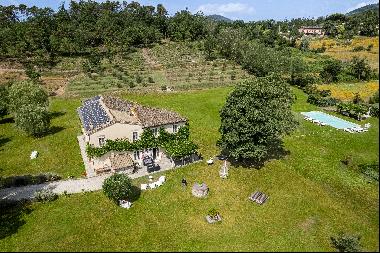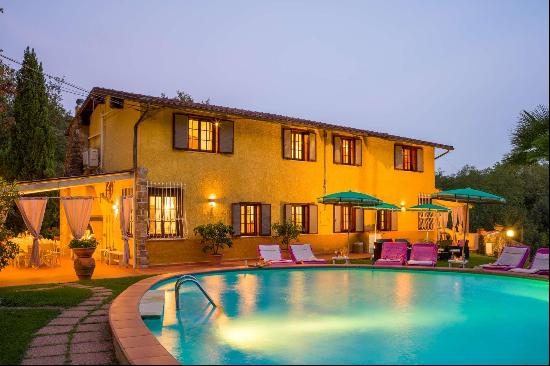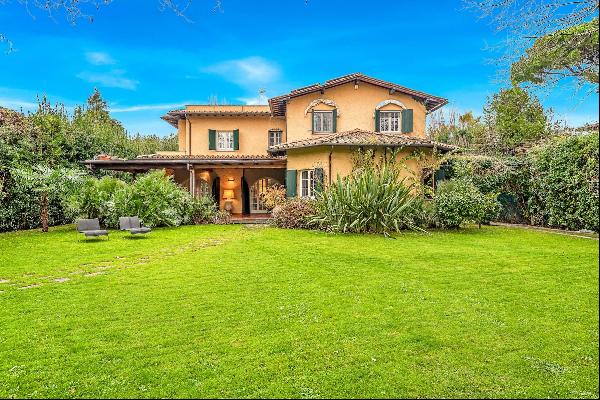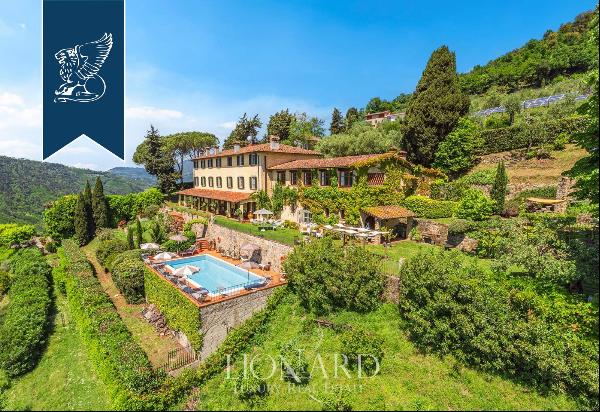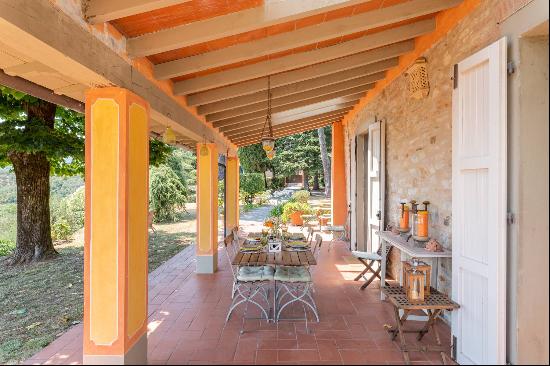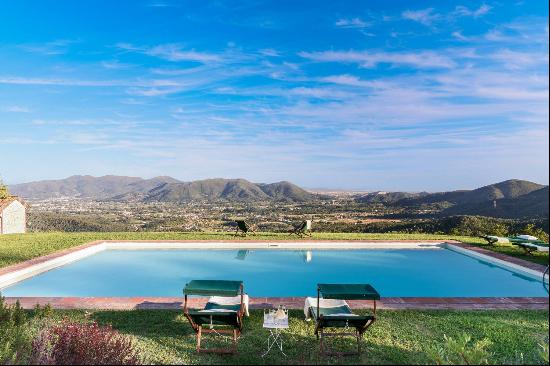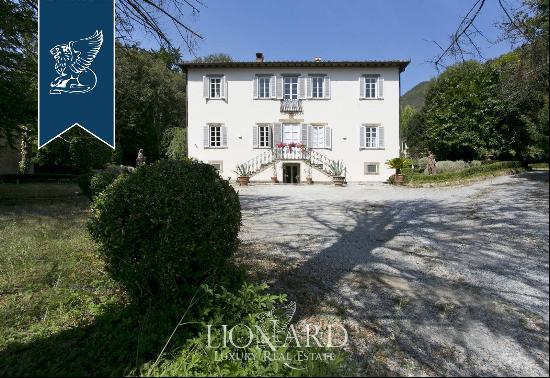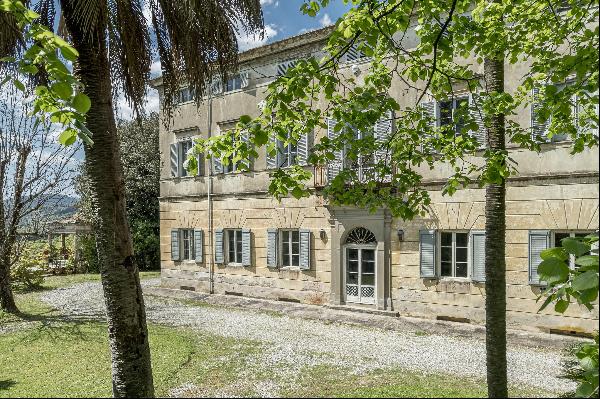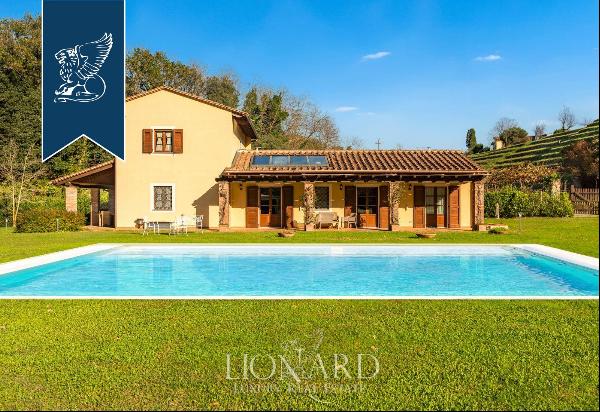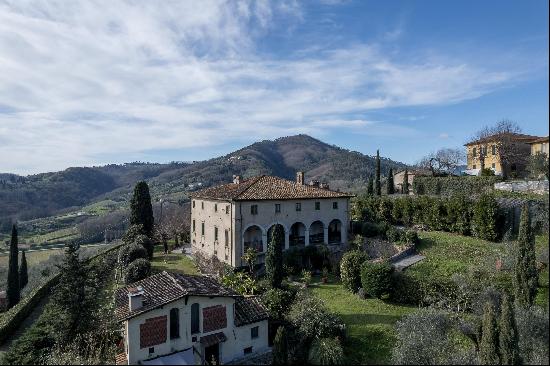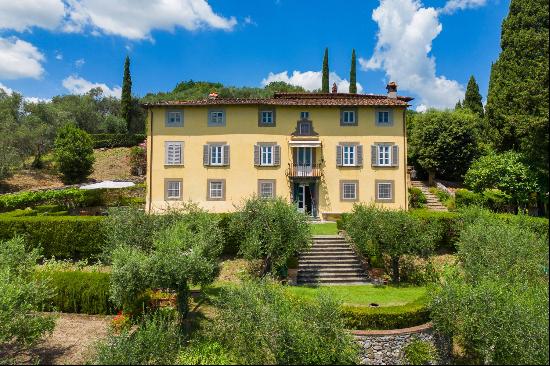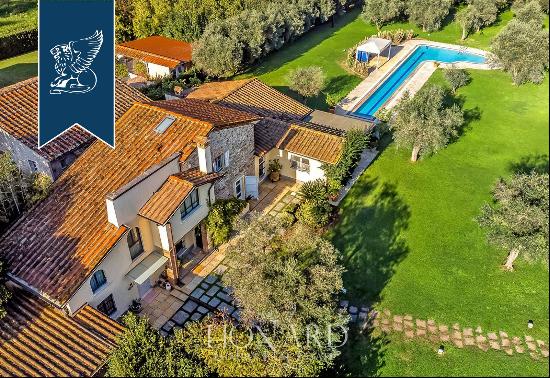



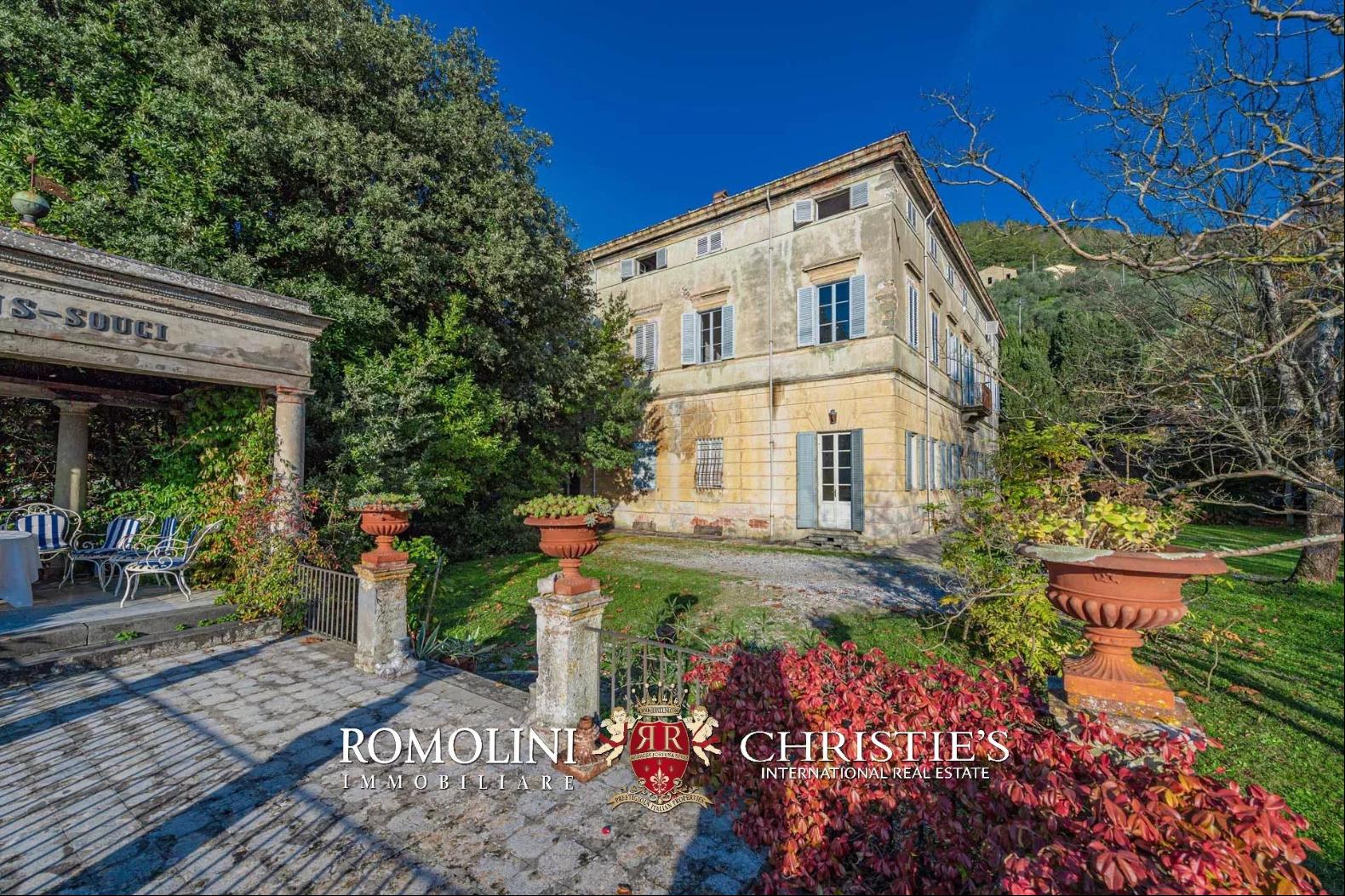

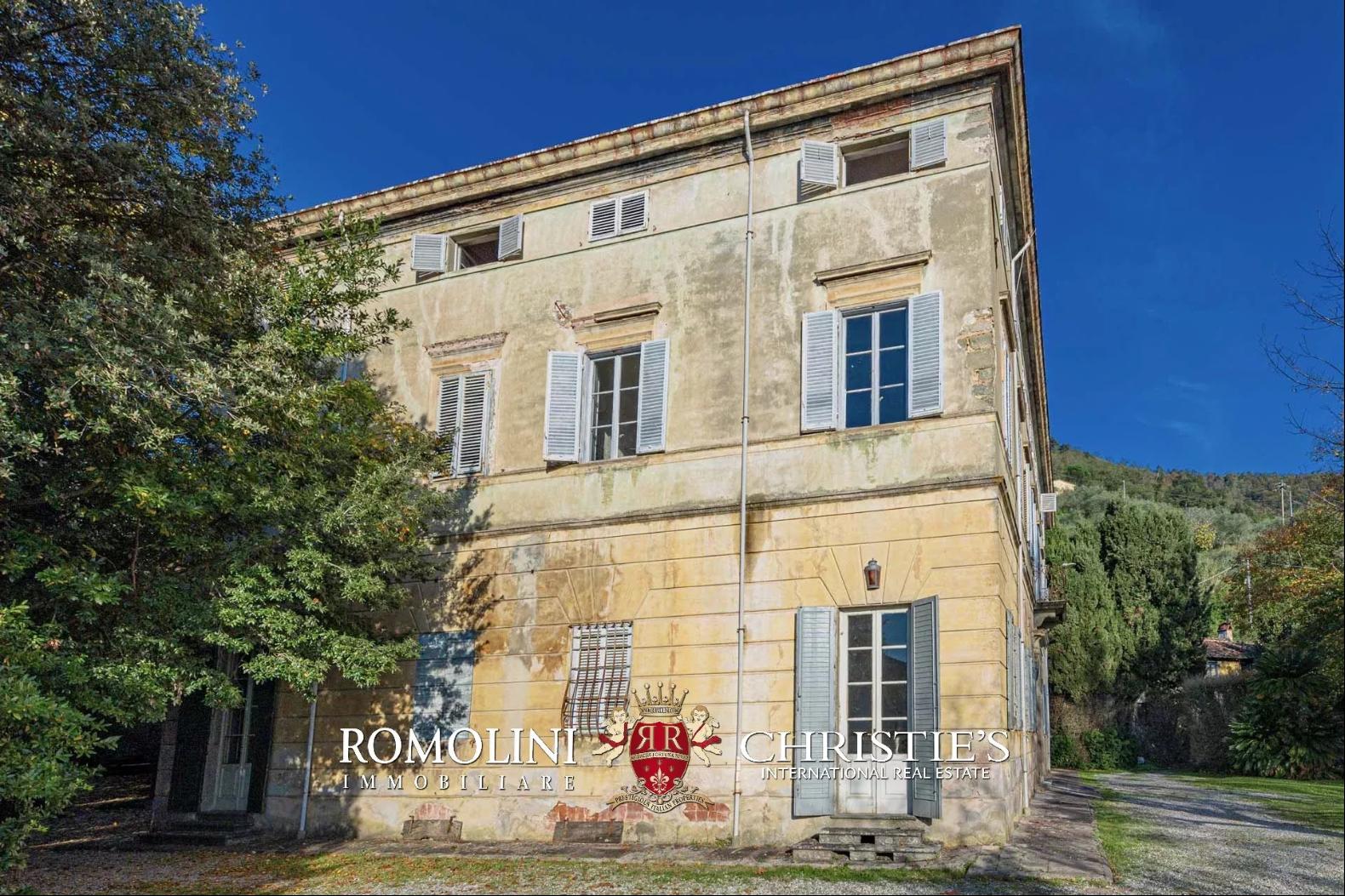







- For Sale
- EUR 2,700,000
- Build Size: 23,949 ft2
- Property Type: Town Villa
- Bedroom: 15
- Bathroom: 9
This manorial villa is set on the hills surrounding Lucca, in a very panoramic position with view over the Serchio Valley. The complex (2,225 sqm) features multiple buildings, partially to be restored, that could be easily converted into guest apartments. As for exteriors, the villa is surrounded by 7,000-sqm garden with exotic and fruit plants, all enclosed by a stone wall granting privacy and safety.
The property is not far from a town providing all the services (2km; 5') and the historic center of Lucca (11km; 20'). From the villa one can then conveniently reach many of the most interesting art cities of Tuscany (Pisa, Forte dei Marmi, San Gimignano, Firenze, Siena, Montepulciano…).
DESCRIPTION OF THE BUILDINGS
The manorial villa (1,500 sqm – 16,140 sqft) is laid over four floors. The basement includes the old cellars where they once stored olive oil and wine. The upper floors include, in total, twenty-nine halls, dining rooms and bedrooms, nine bedrooms (seven of which with bathtubs) and four kitchens (including a historic one, no longer used but very interesting, on the ground floor). The building features two main entrances on the eastern and western façades, a secondary entrance on the northern side and two French windows on the southern side. An external staircase allows entering the first and second floor independently, with the possibility of creating up to five independent apartments inside the villa.
An interesting detail is that the villa is not protected by the Soprintendenza Archeologica Belle Arti e Paesaggio, which means fewer restrictions when restoring and refurbishing the building.
The farmer's house (325 sqm – 3,497 sqft), to be restored, is laid over two floors in the typical rural layout with storages on the ground floor and a house on the first floor. The building also features a private chapel, located in the corner and with independent access from outside.
The old lemon house (130 sqm – 1,399 sqft) was used in the past to shelter plants during winter and features a veranda overlooking the access road and a warehouse for vehicles.
Inside the walls enclosing the property are several secondary buildings, specifically a barn (150 sqm – 1,614 sqft), the old lavatory (25 sqm – 269 sqft) with a pump to take water from the nearby stream, a temple (70 sqm – 753 sqft) with panoramic terrace and portico, the old chicken coop (10 sqm – 108 sqft) and several service buildings (15 sqm – 161 sqft).
STATE AND FINISHES
The villa can be dated to the early 19th century (the temple bears the date 1813) but the foundations of the building are much older, dating back to at least the 11th century. In 1836 the owners undertook a first renovation to convert the whole building into a private home while a last substantial restoration took place in the 1960s. It is interesting to note that, over the last two hundred years, the villa has remained in the hands of the same family.
The villa is in good shape, both aesthetically and structurally, but needs nonetheless to be renovated and updated. Finishes are those typically found in manorial villas in the area of Lucca, commonly featuring decorated marble floors, plaster decorations and trompe-l'œil decorations, frescoed ceilings with Baroque/Neoclassical motives and ample windows that make the rooms very bright and welcoming.
All the rural outbuildings haven't been used for several years and need to be recovered, restored and updated before being usable. These have more rustic features, such as terracotta floors, stone fireplaces and wooden beams, typical of Tuscan countryside buildings.
EXTERIORS
The garden of the villa (over 6,000 sqm), enclosed by a wall, is laid over two levels and includes medicinal and exotic plants such as date palms, sugar maples, camellia, roses, wisteria, linden, holm oaks, planes, orange trees, lemon trees, olive trees, elderberries and boxwood.
The villa also features several olive trees (around 15) that are still used to produce a small quantity of extra-virgin olive oil. This plot of land (roughly 1,000 sqm) is located just outside the wall enclosing the complex.
USE AND POTENTIAL USES
The complex, given its notable size and the internal layouts of the buildings, is very fit to be used either as a private home or as an accommodation business. Ideally, one could split the villa into multiple apartments to rent out, or keep the house for themselves while at the same time renting out the other buildings (once restored and updated).
If interested, close to the villa and separated by just a road, are two additional properties to be bought with separate negotiation. The first element is an old country house with barn and tower (to be fully restored) surrounded by 1,300 sqm of land among courtyards and arable portions. The second element is just a 4,200-sqm agricultural plot of land where are already a few olive trees and ample portions of arable land.
CLOSEST CITIES AND TOWNS
Town with services (2km; 5'), Lucca (11km; 20'), Pisa (29km; 40'), Forte dei Marmi (46km; 50'), Livorno (59km; 1h), San Gimignano (81km; 1h 45'), Florence (82km; 1h 20'), Volterra (84km; 1h 45'), Colle di Val d'Elsa (122km; 1h 30'), Monteriggioni (130km; 1h 35'), Siena (146km; 1h 50'), Montalcino (184km; 2h 30'), Montepulciano (187km; 2h 15')
CLOSEST AIRPORTS
Pisa Galilei (46km; 45'), Firenze Vespucci (74km; 1h), Bologna Marconi (156km; 1h 50'), Genova Colombo (176km; 2h 15'), Roma Ciampino (365km; 3h 50'), Roma Fiumicino (379km; 3h 50')
The property is not far from a town providing all the services (2km; 5') and the historic center of Lucca (11km; 20'). From the villa one can then conveniently reach many of the most interesting art cities of Tuscany (Pisa, Forte dei Marmi, San Gimignano, Firenze, Siena, Montepulciano…).
DESCRIPTION OF THE BUILDINGS
The manorial villa (1,500 sqm – 16,140 sqft) is laid over four floors. The basement includes the old cellars where they once stored olive oil and wine. The upper floors include, in total, twenty-nine halls, dining rooms and bedrooms, nine bedrooms (seven of which with bathtubs) and four kitchens (including a historic one, no longer used but very interesting, on the ground floor). The building features two main entrances on the eastern and western façades, a secondary entrance on the northern side and two French windows on the southern side. An external staircase allows entering the first and second floor independently, with the possibility of creating up to five independent apartments inside the villa.
An interesting detail is that the villa is not protected by the Soprintendenza Archeologica Belle Arti e Paesaggio, which means fewer restrictions when restoring and refurbishing the building.
The farmer's house (325 sqm – 3,497 sqft), to be restored, is laid over two floors in the typical rural layout with storages on the ground floor and a house on the first floor. The building also features a private chapel, located in the corner and with independent access from outside.
The old lemon house (130 sqm – 1,399 sqft) was used in the past to shelter plants during winter and features a veranda overlooking the access road and a warehouse for vehicles.
Inside the walls enclosing the property are several secondary buildings, specifically a barn (150 sqm – 1,614 sqft), the old lavatory (25 sqm – 269 sqft) with a pump to take water from the nearby stream, a temple (70 sqm – 753 sqft) with panoramic terrace and portico, the old chicken coop (10 sqm – 108 sqft) and several service buildings (15 sqm – 161 sqft).
STATE AND FINISHES
The villa can be dated to the early 19th century (the temple bears the date 1813) but the foundations of the building are much older, dating back to at least the 11th century. In 1836 the owners undertook a first renovation to convert the whole building into a private home while a last substantial restoration took place in the 1960s. It is interesting to note that, over the last two hundred years, the villa has remained in the hands of the same family.
The villa is in good shape, both aesthetically and structurally, but needs nonetheless to be renovated and updated. Finishes are those typically found in manorial villas in the area of Lucca, commonly featuring decorated marble floors, plaster decorations and trompe-l'œil decorations, frescoed ceilings with Baroque/Neoclassical motives and ample windows that make the rooms very bright and welcoming.
All the rural outbuildings haven't been used for several years and need to be recovered, restored and updated before being usable. These have more rustic features, such as terracotta floors, stone fireplaces and wooden beams, typical of Tuscan countryside buildings.
EXTERIORS
The garden of the villa (over 6,000 sqm), enclosed by a wall, is laid over two levels and includes medicinal and exotic plants such as date palms, sugar maples, camellia, roses, wisteria, linden, holm oaks, planes, orange trees, lemon trees, olive trees, elderberries and boxwood.
The villa also features several olive trees (around 15) that are still used to produce a small quantity of extra-virgin olive oil. This plot of land (roughly 1,000 sqm) is located just outside the wall enclosing the complex.
USE AND POTENTIAL USES
The complex, given its notable size and the internal layouts of the buildings, is very fit to be used either as a private home or as an accommodation business. Ideally, one could split the villa into multiple apartments to rent out, or keep the house for themselves while at the same time renting out the other buildings (once restored and updated).
If interested, close to the villa and separated by just a road, are two additional properties to be bought with separate negotiation. The first element is an old country house with barn and tower (to be fully restored) surrounded by 1,300 sqm of land among courtyards and arable portions. The second element is just a 4,200-sqm agricultural plot of land where are already a few olive trees and ample portions of arable land.
CLOSEST CITIES AND TOWNS
Town with services (2km; 5'), Lucca (11km; 20'), Pisa (29km; 40'), Forte dei Marmi (46km; 50'), Livorno (59km; 1h), San Gimignano (81km; 1h 45'), Florence (82km; 1h 20'), Volterra (84km; 1h 45'), Colle di Val d'Elsa (122km; 1h 30'), Monteriggioni (130km; 1h 35'), Siena (146km; 1h 50'), Montalcino (184km; 2h 30'), Montepulciano (187km; 2h 15')
CLOSEST AIRPORTS
Pisa Galilei (46km; 45'), Firenze Vespucci (74km; 1h), Bologna Marconi (156km; 1h 50'), Genova Colombo (176km; 2h 15'), Roma Ciampino (365km; 3h 50'), Roma Fiumicino (379km; 3h 50')


